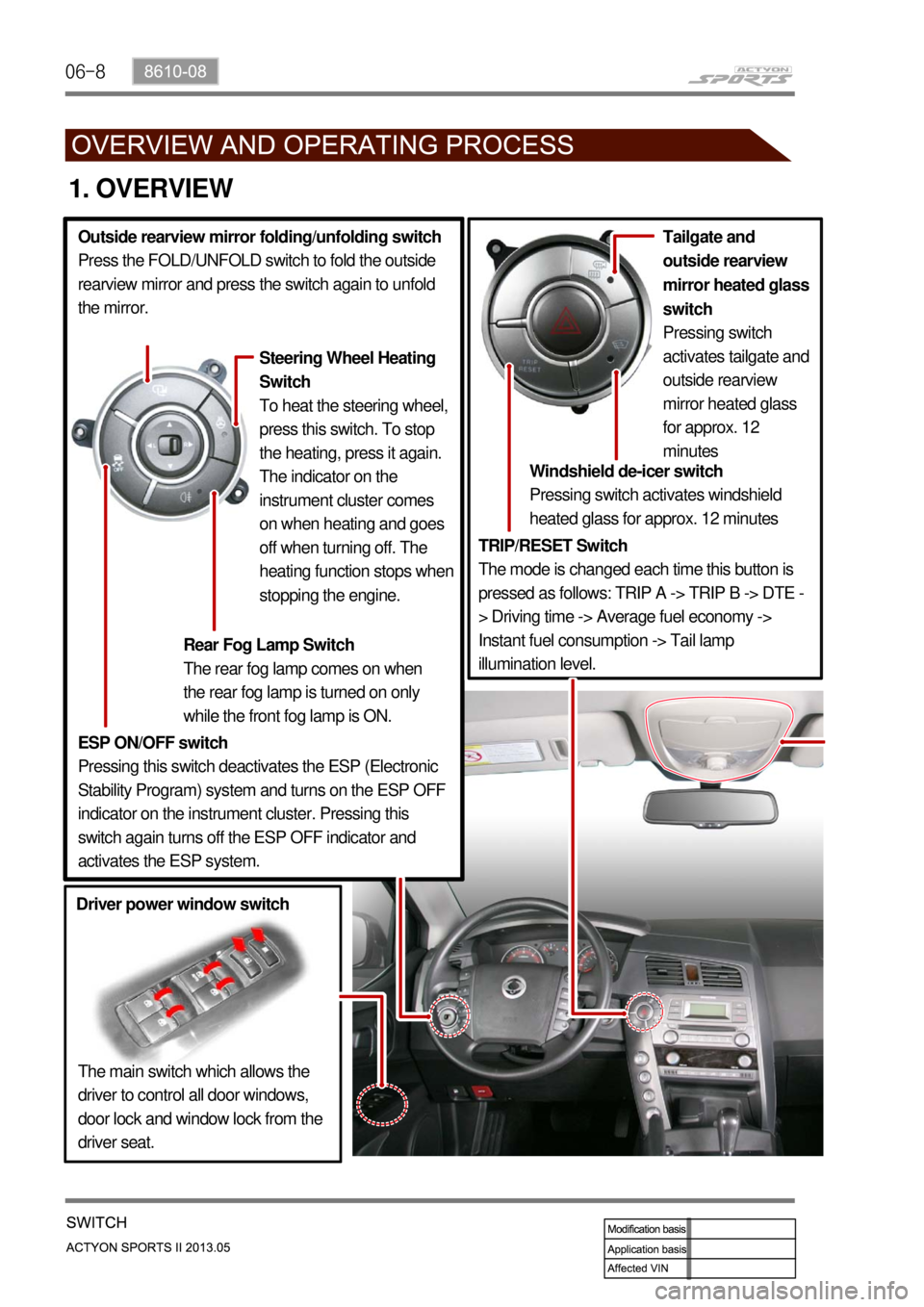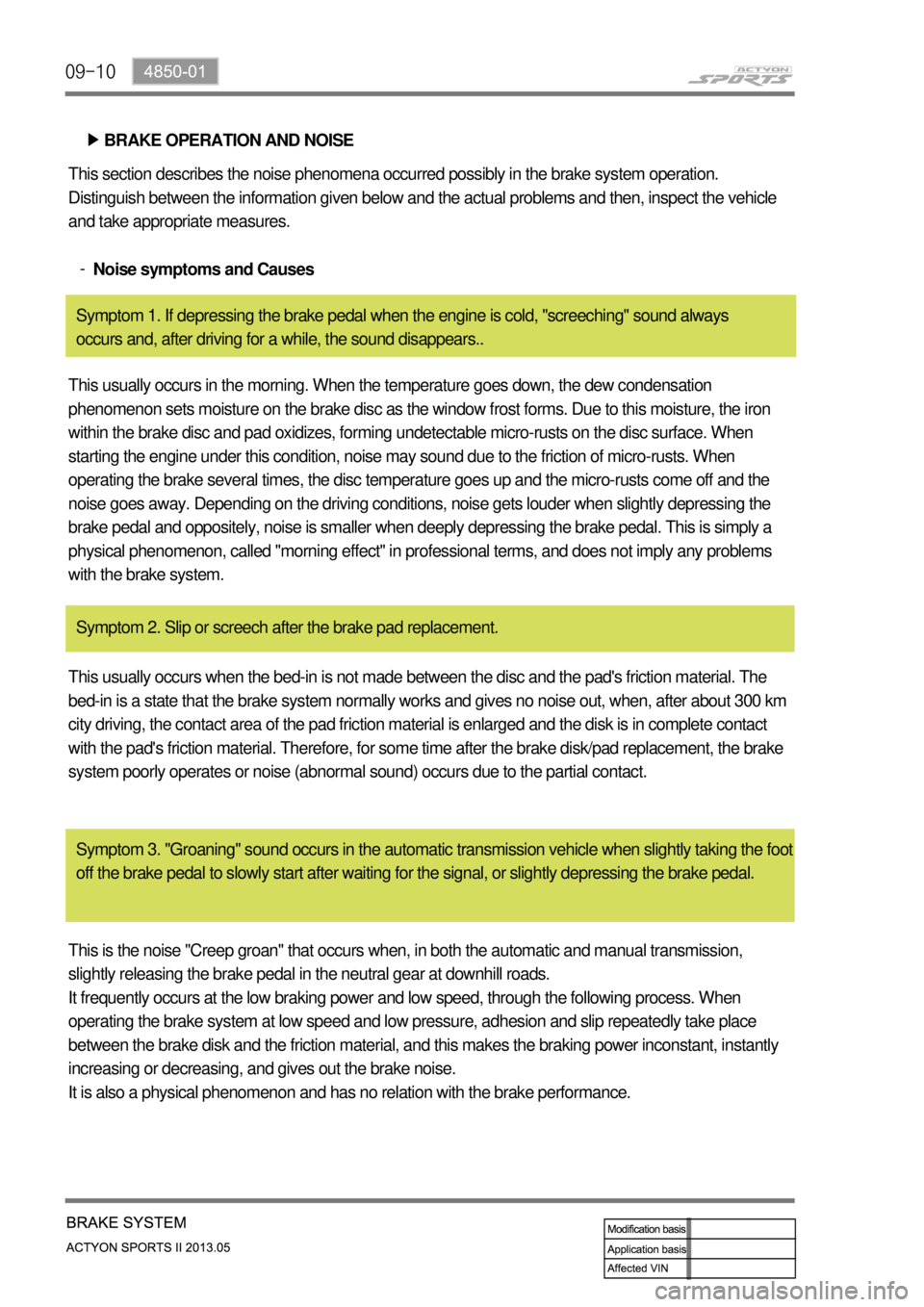2013 SSANGYONG NEW ACTYON SPORTS window
[x] Cancel search: windowPage 223 of 751

15-230000-00
(7) Knocking Control
A. Resetting the pilot injection
The knocking control is used to reset the pilot injection flow in closed loop for each injector. This method
allows the correction of any injector deviations over a period of time. The principle of use of the knocking
control is based on the detection of the combustion noises.
The sensor is positioned in such a way as to receive the maximum signal for all the cylinders. The raw
signals from the knock sensor are processed to obtain a variable which quantifies the intensity of the
combustion. This variable, known as the ratio, consists of the ratio between the intensity of the
background noise and the combustion noise.
A first window is used to establish the background noise level of the knocking control signal for each
cylinder. This window must therefore be positioned at a moment when there cannot be any
combustion.
The second window is used to measure the intensity of the pilot combustion. Its position is such that
only the combustion noises produced by the pilot injection are measured . It is therefore placed just
before the main injection. 1.
2.
The knock sensor does not allow any evaluation of the quantity injected. However, the pulse value will
be measured when the injector starts injection and this pulse value is called the MDP (Minimum Drive
Pulse). On the basis of this information, it is possible to efficiently correct the pilot flows. The pilot
injection resetting principle therefore consists of determining the MDP, in other words the pulse
corresponding to the start of the increase in value of the ratio (increase of vibration due to fuel
combustion).
Page 224 of 751

15-24
This is done periodically under certain operating conditions. When the resetting is finished, the new
minimum pulse value replaces the value obtained during the previous resetting. The first MDP value is
provided by the C3I. Each resetting then allows the closed loop of the MDP to be updated according to
the deviation of the injector.
B. Detection of leaks in the cylinders
The accelerometer is also used to detect any injector which may have stuck open. The detection
principle is based on monitoring the ratio. If there is a leak in the cylinder, the accumulated fuel self-
ignites as soon as the temperature and pressure conditions are favorable (high engine speed, high load
and small leak).
This combustion is set off at about 20 degrees before TDC and before main injection.
The ratio therefore increases considerably in the detection window. It is this increase which allows the
leaks to be detected. The threshold beyond which a fault is signaled is a percentage of the maximum
possible value of the ratio.
Because of the severity of the recovery process (engine shut-down), the etection must be extremely
robust.
An increase in the ratio can be the consequence of various causes:
Pilot injection too much
Main combustion offset
Fuel leak in the cylinder -
-
-
If the ratio becomes too high, the strategy initially restricts the pilot injection flow and retards the main
injection. If the ratio remains high despite these interventions, this shows that a real leak is present, a
fault is signaled and the engine is shut down.
C. Detection of an accelerometer fault
This strategy permits the detection of a fault in the sensor or in the wiring loom connecting the sensor to
the ECU.
It is based on detection of the combustion. When the engine is idling, the detection window is set too low
for the combustion caused by the main injection. If the ratio increases, this shows that the knock sensor
is working properly, but otherwise a fault is signaled to indicate a sensor failure. The recovery modes
associated with this fault consist of inhibition of the pilot injection and discharge through the injectors.
Page 313 of 751

02-38710-01
1. PERFORMANCE AND SPECIFICATIONS
1) Rated Load & Input Signals
Rated Load
▶
NO.
Item Rated Load
1 Chime bell / Buzzer DC 12V 350 mA (Inductive load)
2 Front room lamp DC 12V 16W (Lamp load)
3 Rear room lamp DC 12V 8W (Lamp load)
4 Ignition key illumination DC 12V 1.2W (Lamp load)
5 Seat belt indicator DC 12V 1.2W (Lamp load)
6 Parking brake warning lamp DC 12V 1.2W (Lamp load)
7 Door ajar warning lamp DC 12V 1.2W (Lamp load)
8 Door lock relay DC 12V 200 mA (Inductive load)
9 Door unlock relay DC 12V 200 mA (Inductive load)
10 Horn relay DC 12V 260 mA
11 Tail lamp relay DC 12V 200 mA (Inductive load)
12 Hazard warning lamp relay DC 12V 200 mA (Inductive load)
13 Power window relay DC 12V 200 mA (Inductive load)
14 Rear defogger relay DC 12V 200 mA (Inductive load)
15 Wiper LOW relay DC 12V 200 mA (Inductive load)
16 Wiper HIGH relay DC 12V 200 mA (Inductive load)
17 Front washer motor DC 12V 1.5A
18 Head lamp relay DC 12V 750 mA (Inductive load)
19 Front defogger relay DC 12V 200 mA (Inductive load)
20 Mirror lock relay DC 12V 200 mA (Inductive load)
21 Mirror unlock relay DC 12V 200 mA (Inductive load)
Page 345 of 751

02-358710-01
The defogger system uses the heated glass to remove the moisture and fro\
st on the windows, which
can disturb safe driving.
The defogger (including de-icer) activates the corresponding switch an\
d the STICS controls the
operating time.Tailgate and outside rearview mirror
heated glass switch
Pressing switch activates tailgate and outside
rearview mirror heated glass for approx. 12
minutes
Windshield heated glass (de-icer) switch
Pressing switch activates windshield heated
glass for approx. 12 minutes
Page 353 of 751

02-438710-01
▶Time Lag Power Window Control
The power window relay output is "ON" when turning on the ignition switc\
h.
The power window relay output is "ON" for 30 seconds when turning off th\
e ignition switch.
The power window relay output is "OFF" when opening the driver's door or the passenger's
door.
The power window relay is turned "OFF" when receiving the remote control\
key lock signal
(armed mode) during its extended operation period of 30 seconds.
1.
2.
3.
Page 415 of 751

06-8
1. OVERVIEW
TRIP/RESET Switch
The mode is changed each time this button is
pressed as follows: TRIP A -> TRIP B -> DTE -
> Driving time -> Average fuel economy ->
Instant fuel consumption -> Tail lamp
illumination level.Windshield de-icer switch
Pressing switch activates windshield
heated glass for approx. 12 minutes
The main switch which allows the
driver to control all door windows,
door lock and window lock from the
driver seat. Tailgate and
outside rearview
mirror heated glass
switch
Pressing switch
activates tailgate and
outside rearview
mirror heated glass
for approx. 12
minutes
Driver power window switchESP ON/OFF switch
Pressing this switch deactivates the ESP (Electronic
Stability Program) system and turns on the ESP OFF
indicator on the instrument cluster. Pressing this
switch again turns off the ESP OFF indicator and
activates the ESP system. Outside rearview mirror folding/unfolding switch
Press the FOLD/UNFOLD switch to fold the outside
rearview mirror and press the switch again to unfold
the mirror.
Rear Fog Lamp Switch
The rear fog lamp comes on when
the rear fog lamp is turned on only
while the front fog lamp is ON.
Steering Wheel Heating
Switch
To heat the steering wheel,
press this switch. To stop
the heating, press it again.
The indicator on the
instrument cluster comes
on when heating and goes
off when turning off. The
heating function stops when
stopping the engine.
Page 448 of 751

10-8
2. SWITCH
No. Name and Function
1 RDS setup
2 AF/TA selection
3 Start call
4 USB, AUX, CD selection
5 Power (ON/OFF), Mute, Volume
6 Preset key #1, Intro SCAN
7 Preset key #2, RPT
8 Preset key #3, Random
9 Preset key #4, folder down
10 Preset key #5, folder up
11 Preset key #6, File guide
12 AST, SCAN, TUNE UP/DOWN
13 Eject
14 End call
15 Set
16 Band
17 LCD window
Page 559 of 751

09-10
This section describes the noise phenomena occurred possibly in the brake system operation.
Distinguish between the information given below and the actual problems and then, inspect the vehicle
and take appropriate measures.
Noise symptoms and Causes -
Symptom 1. If depressing the brake pedal when the engine is cold, "screeching" sound always
occurs and, after driving for a while, the sound disappears..
This usually occurs in the morning. When the temperature goes down, the dew condensation
phenomenon sets moisture on the brake disc as the window frost forms. Due to this moisture, the iron
within the brake disc and pad oxidizes, forming undetectable micro-rusts on the disc surface. When
starting the engine under this condition, noise may sound due to the friction of micro-rusts. When
operating the brake several times, the disc temperature goes up and the micro-rusts come off and the
noise goes away. Depending on the driving conditions, noise gets louder when slightly depressing the
brake pedal and oppositely, noise is smaller when deeply depressing the brake pedal. This is simply a
physical phenomenon, called "morning effect" in professional terms, and does not imply any problems
with the brake system.
Symptom 2. Slip or screech after the brake pad replacement.
This usually occurs when the bed-in is not made between the disc and the pad's friction material. The
bed-in is a state that the brake system normally works and gives no noise out, when, after about 300 km
city driving, the contact area of the pad friction material is enlarged and the disk is in complete contact
with the pad's friction material. Therefore, for some time after the brake disk/pad replacement, the brake
system poorly operates or noise (abnormal sound) occurs due to the partial contact.
Symptom 3. "Groaning" sound occurs in the automatic transmission vehicle when slightly taking the foot
off the brake pedal to slowly start after waiting for the signal, or slightly depressing the brake pedal.
This is the noise "Creep groan" that occurs when, in both the automatic and manual transmission,
slightly releasing the brake pedal in the neutral gear at downhill roads.
It frequently occurs at the low braking power and low speed, through the following process. When
operating the brake system at low speed and low pressure, adhesion and slip repeatedly take place
between the brake disk and the friction material, and this makes the braking power inconstant, instantly
increasing or decreasing, and gives out the brake noise.
It is also a physical phenomenon and has no relation with the brake performance.BRAKE OPERATION AND NOISE ▶